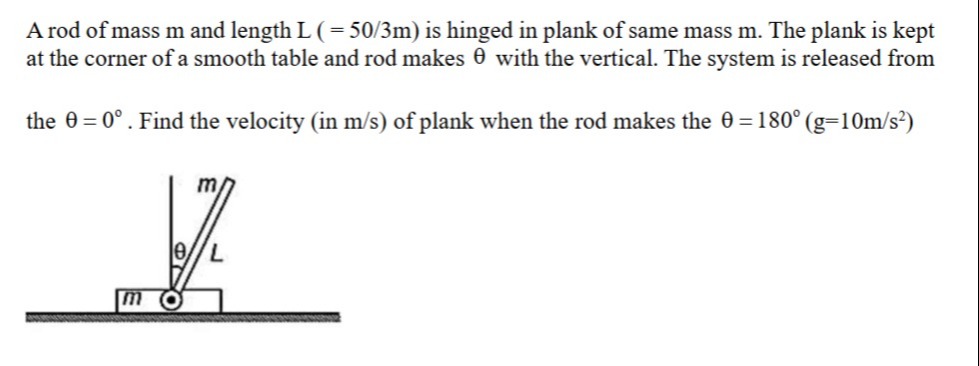Question
Question: A rod of mass m and length L (= 50/3m) is hinged in plank of same mass m. The plank is kept at the c...
A rod of mass m and length L (= 50/3m) is hinged in plank of same mass m. The plank is kept at the corner of a smooth table and rod makes θ with the vertical. The system is released from the θ = 0°. Find the velocity (in m/s) of plank when the rod makes the θ = 180° (g=10m/s²)

10
Solution
Solution Explanation
-
Conservation of Horizontal Momentum:
Let the plank’s velocity be v to the right and the rod’s angular velocity be ω.
At the instant θ=180∘ (rod vertical downward), the rod’s center of mass (located at L/2 from the hinge) has a relative horizontal speed 2Lω (to the left).
Thus, the rod’s horizontal speed in the lab frame is v−2Lω.
Since total horizontal momentum begins at 0:
mv+m(v−2Lω)=0⟹2v−2Lω=0 So,
ω=L4v. -
Conservation of Energy:
Loss in gravitational potential energy of the rod’s center of mass as it falls a distance L is mgL.
The final kinetic energy consists of three parts:
- Plank’s translational KE: 21mv2.
- Rod’s translational KE (of its center of mass): 21m(v−2Lω)2.
- Rod’s rotational KE about its center of mass: 21Icmω2, with Icm=121mL2.
At θ=180∘ the rod is vertical downward so v−2Lω=v−2L(L4v)=v−2v=−v, and (v−2v)2=v2.
Thus, the energy equation becomes: mgL=21mv2+21mv2+21(121mL2)ω2. Substitute ω=L4v: mgL=mv2+21(121mL2)(L216v2) =mv2+128mv2 =mv2+32mv2 =35mv2. Cancelling m gives: 35v2=gL⟹v2=53gL.
- Substitute Given Values:
g=10m/s2 and L=350m: v2=53×10×350 =510×50 =5500=100, so v=100=10m/s.
Answer:
The velocity of the plank when the rod makes θ=180∘ is 10 m/s.
Metadata:
-
Subject: Physics
-
Chapter: Mechanics
-
Topic: Conservation of Energy & Momentum (Rotational Motion)
-
Difficulty Level: Hard
-
Question Type: single_choice (if options provided) / integer (value answer)
